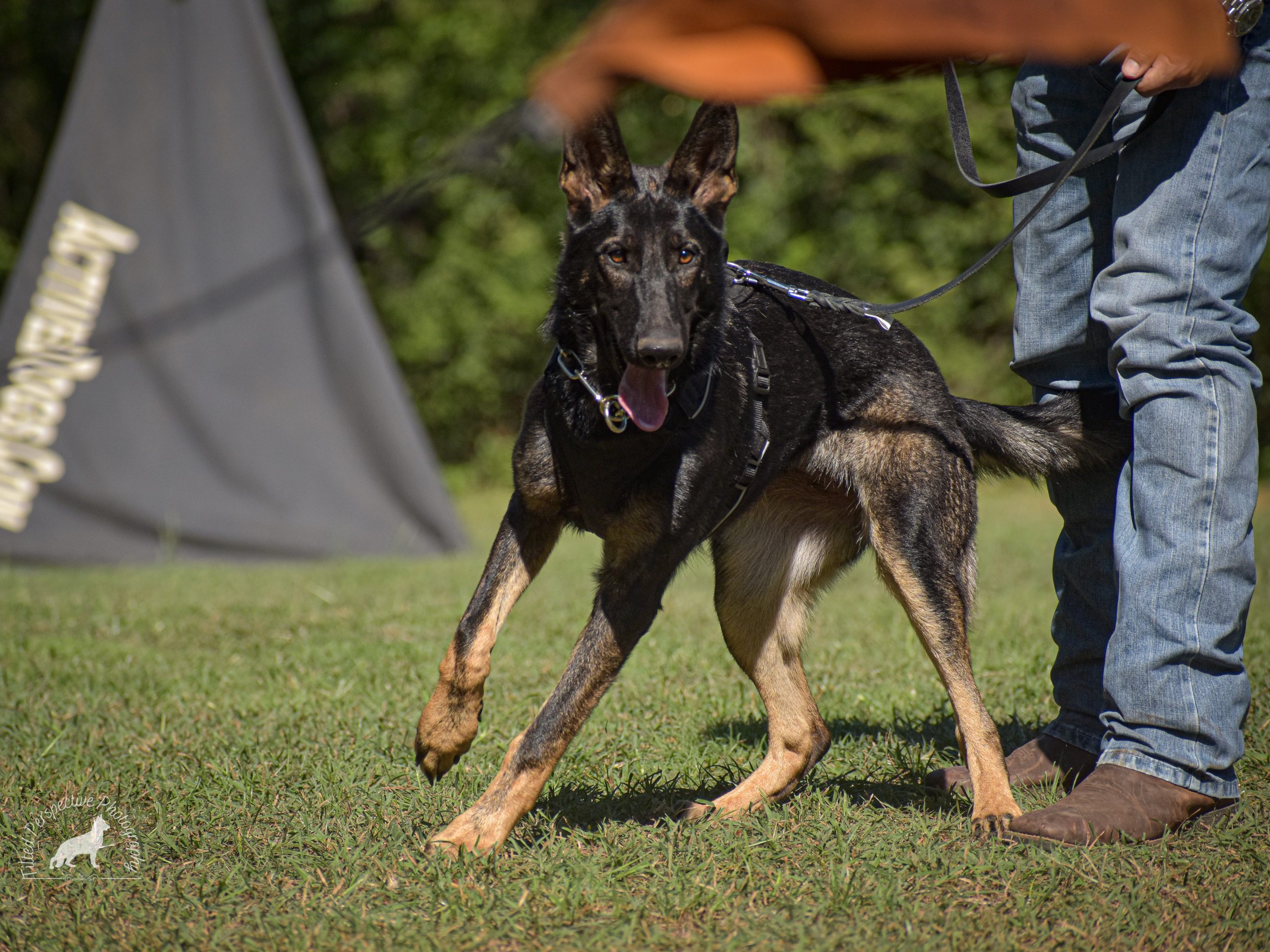Ball Drive in Working Line German Shepherd Puppies
Ball drive in Schutzhund dogs refers to a specific type of motivation and behavior in which working line German Shepherd puppies exhibits a strong desire, excitement, and focus on playing with a ball as a reward or during training exercises. Ball drive is a valuable trait in Schutzhund training as it can be utilized as a powerful motivator to enhance engagement, enthusiasm, and performance in various tasks and activities.
Key features of ball drive in Schutzhund dogs include
1. Motivation: Dogs with high ball drive are often highly motivated by the opportunity to play with a ball, demonstrating an intense desire and eagerness to engage in retrieving, chasing, or interacting with the ball as a reward. The ball serves as a positive reinforcement tool that stimulates and maintains the dog’s interest and responsiveness during training sessions.
2. Focus and Engagement: Ball drive fosters intense focus, concentration, and engagement in working line German Shepherd puppies, redirecting their attention towards the ball and the associated tasks or commands provided by the handler. Dogs with strong ball drive exhibit heightened attentiveness, responsiveness, and enthusiasm when the ball is used as a training aid or reward.
3. Reward System: The ball serves as a valuable reward system for reinforcing desired behaviors, responses, or achievements during training exercises. Dogs with ball drive view playing with the ball as a fulfilling and enjoyable activity, motivating them to perform tasks, commands, or exercises effectively to earn playtime with the ball.
4. Training Tool: Ball drive can be harnessed as an effective training tool to enhance motivation, responsiveness, and performance in Schutzhund tasks such as obedience, agility, and tracking. Trainers can leverage the working line German Shepherd puppies inherent ball drive to facilitate learning, engagement, and positive reinforcement in various training scenarios.
5. Physical Exercise: Playing with a ball provides Schutzhund dogs with physical exercise, mental stimulation, and enrichment, contributing to their overall well-being, fitness, and behavioral development. Ball play can serve as a recreational outlet for dogs to release excess energy, engage in interactive play, and strengthen the bond between the dog and its handler.
6. Drive Management: Effective management of ball drive involves balancing the working line German Shepherd puppies enthusiasm and excitement with control, focus, and obedience during training sessions. Trainers must establish clear rules, boundaries, and expectations regarding ball play to reinforce discipline, attentiveness, and appropriate behavior in the dog.
7. Problem-Solving and Task Engagement: Dogs with high ball drive often exhibit problem-solving skills, task engagement, and persistence when presented with challenges or objectives involving the ball. Ball play encourages dogs to actively participate, problem-solve, and demonstrate initiative in achieving goals or completing tasks set by the handler.
Developing Ball Drive in Adolescent German Shepherd puppies
Developing ball drive in Schutzhund training is a crucial aspect of enhancing motivation, focus, and engagement in training exercises. By fostering a strong affinity for playing with a ball as a reward, trainers can harness the dog’s natural drives and instincts to optimize performance and enthusiasm in Schutzhund tasks. Here are key strategies and tips for cultivating ball drive in adolescent German Shepherd puppies for Schutzhund training:
1. Early Introduction: Begin introducing the ball as a motivational tool from a young age to acclimate the working line German Shepherd puppies to the concept of ball play. Incorporate the ball into daily play sessions, training activities, and interactions to establish positive associations and a sense of familiarity with the ball.
2. Interactive Play: Engage in interactive play sessions with the puppy using the ball to stimulate its interest, curiosity, and enthusiasm. Encourage chasing, retrieving, and exchanging the ball as part of fun and engaging play sessions that promote bonding, physical activity, and mental stimulation.
3. Positive Reinforcement: Use the ball as a primary positive reinforcement tool to reward desired behaviors, responses, or achievements during training exercises. Pair the ball with praise, treats, or playtime to reinforce obedience, focus, and performance, encouraging the puppy to associate the ball with pleasure, rewards, and success.
4. Variety and Novelty: Introduce a variety of balls, toys, or objects of different textures, sizes, and shapes to appeal to the working line German Shepherd puppies sensory and tactile preferences. Experiment with different types of balls such as rubber, tennis, or interactive treat-dispensing balls to create a stimulating and engaging play experience.
5. Drive Building Activities: Incorporate drive-building activities and exercises that encourage the puppy to enhance its prey drive, chase instincts, and retrieval skills with the ball. Implement activities such as hide-and-seek, fetch, tug-of-war, and structured play routines that promote drive development, focus, and determination during interactive play.
6. Short and Engaging Sessions: Keep training sessions short, engaging, and dynamic to maintain the puppy’s interest, attention span, and energy levels during ball play. Break down training exercises into short intervals, interspersed with play breaks, rewards, and positive interactions to sustain motivation and enthusiasm throughout the session.
7. Positive Association: Create a positive association with the ball by incorporating the working line German Shepherd puppies favorite treats, activities, or games during ball play. Pair the ball with high-value rewards, verbal praise, and affectionate gestures to reinforce the puppy’s positive responses, behavior, and engagement with the ball as a motivational tool.
8. Challenge and Progression: Gradually increase the level of difficulty, challenges, and tasks associated with ball play to promote problem-solving, initiative, and skill development in the puppy. Introduce new commands, obstacles, or games that elevate the level of engagement, focus, and drive required from the puppy during ball-driven activities.
9. Consistency and Patience: Maintain consistency, patience, and positive reinforcement throughout the ball drive development process to build trust, confidence, and a strong bond between the puppy and the handler. Encourage persistence, effort, and improvement in the puppy’s ball play skills while offering guidance, support, and encouragement during training activities.
By implementing these strategies and techniques, trainers can effectively cultivate ball drive in adolescent German Shepherd puppies for Schutzhund training, nurturing motivation, focus, and enthusiasm in the dog’s learning experience and performance in Schutzhund tasks. Through structured, engaging, and rewarding ball-driven activities, puppies can develop a keen affinity for ball play, strong work ethic, and drive to excel in Schutzhund training with vigor, determination, and excitement.
Overall, ball drive in Schutzhund dogs plays a crucial role in fostering motivation, engagement, and performance in training activities, enriching the training experience, and enhancing the dog’s abilities, focus, and responsiveness in various Schutzhund tasks and exercises. By understanding and harnessing the dog’s ball drive effectively, trainers can optimize training outcomes, strengthen the dog-handler relationship, and cultivate a positive and rewarding training environment for Schutzhund dogs. Here at Czech Working Line, we routinely publish new article on training German Shepherd puppies. Go to our article section on Dog training for more articles.




